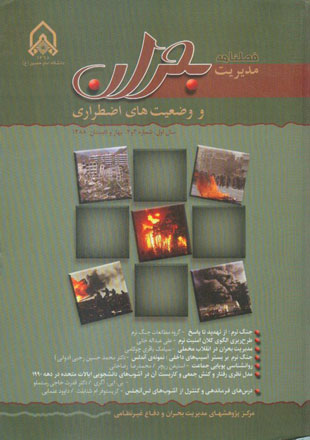فهرست مطالب

فصلنامه مدیریت بحران و وضعیت های اضطراری
پیاپی 3-4 (بهار و تابستان 1388)
- بهای روی جلد: 20,000ريال
- تاریخ انتشار: 1388/06/18
- تعداد عناوین: 7
-
صفحه 7
-
صفحه 45
-
صفحه 71
-
صفحه 131
-
Page 7At times, some concepts and words denote paradigmatic changes. Among such concepts, one may refer to soft war and soft threat. They do not merely refer to the emergence of new confrontation methods or novel security and political developments; rather, beyond that, they signify the emergence of new doctrines in the context of international rivalries and conflicts. Based on this assumption and considering the conceptual confusion and theoretical perplexity commonly observed in this field, the present article attempts to provide definitions and theoretical models to clarify the boundaries and limits of these concepts benefiting from the scientific literature and making inferences from similar incidents.Keywords: soft threat, soft war, crisis management, riot, psychological operations
-
Page 45Security is a comprehensive social, political, cultural and military issue whose elements must all have balanced development. In this respect, it can be said that soft security isn’t a special area, topic, phenomenon or condition in national security. Rather, it is a representation of national security that has overshadowed it all or has allocated a part of national security as a whole to itself. In fact, focusing on soft threat areas, soft security attempts to prevent and remedy the respective problems. Utilizing this comprehensive look at soft security, the present article attempts to identify the relevant vulnerability areas. Therefore, to outline a comprehensive model of soft security, four general lines of the issue are introduced, defined and analyzed. Finally, some principles are offered for optimal management in the field of soft security.Keywords: soft security, security, related management, softy power
-
Page 71During the history of the appearance and fall of governments, different kinds of methods and campaigns have been recorded each of which with its particular elements and specifications has led to the transformation andoverthrow of governments. During the recent years, a strategic sort of toppling governments has occurred in the world particularly in the countries detached from The Union of Soviet Republics which is called “velvet revolution”. The major questions dealt with in this article are: How do the internal and external agents of velvet revolutions manage their victory and establishment of these revolutions?, and Have the established political systems been unable to manage and control the crisis? To answer these questions, a descriptive-analytic research method along with library instruments have been utilized. The findings indicate that considering the mental and physical structures of these areas, the management model employed in these revolutions has been “bipolar” and their accompanying and supplementing each other as well as the inability of the ruling political system to distinguish them have played the key role in accomplishment of color revolutions.Keywords: revolution, velvet revolution, overthrow, riot, referendum, civil disobedience, peaceful fighting, crisis management
-
Page 109In late first century (H), influenced by religious incentives and passion, Muslims dominated the whole Andalusia and even found their way far into France with exceptional speed. However, as time passed by, emergence of disagreement among Muslims, attempts of different rival groups of Muslims to expand their power as well as the prevalence of materialistic desires among most of them, particularly their leaders and chiefs, paved the way for declining of their power.Their enemies gradually got stronger taking advantage of the internal disagreements, weakness of faith and prevalence of materialistic desires among Muslims. Waging a soft war and encouraging corruption and prostitution, their enemies managed to weaken Muslims’ authority and sovereignty. Then, they got engaged in hard war and ultimately they put an end to the authority and rulership of Muslims and even their presence in Andalusia.This article examines the causes and backgrounds of the decline of Muslims and their exemplary fate in Andalusia.Keywords: Muslims of Andalusia, internal disagreements, soft war
-
Page 131Crowds as the major source of riots and civil disturbances including those in color revolutions have always been of concern to the specialists in different fields of humanities. This article, first, explains the classical outlook on studying crowds which is associated with authorities such as Gabriel Tarde and his idea of mass society and Gustave Le Bon and his idea of group mentality. Then, Allport’s biological theory on crowd behavior is dealt with and after that the theory of novel anomalies associated with researchers such as Ash and Killian and the social identity model of researchers such as Raicher and Hoge are analyzed. Finally, the categorization theory and the expanded social identity model are explained.Keywords: crowd, riot, group psychology, identity
-
Page 195The paper offers a conceptualization of Collective behavior and action incidents, defining them as suffused y socio-cultural emergence, inextricably dramaturgical in nature, exhibiting a limited range of dominant emotions, carried out by five master social units (masses, publics, associational networks, social movement organizations, and small groups), and located both in time and space as well as in social spaces reflecting issues associated with master categories of age, race/ethnicity, class/occupation, gender/sex, and ethnocentrism/nationalism. It then applies the scheme to student riots in the 1990s in the United States.Keywords: Student Riots, Collective Action, Process View, Static View
-
Page 219Police officers responded to a domestic dispute, accompanied by marines. They had just gone up to the door when two shotgun birdshot rounds were fired through the door, hitting the officers. One yelled `cover me!' to the marines, who then laid down a heavy base of fire.. .. The police officer had not meant `shoot' when he yelled `cover me' to the marines. [He] meant. .. point your weapons and be prepared to respond if necessary. However, the marines responded instantly in the precise way they had been trained, where `cover me' means provide me with cover using firepower.. .. over two hundred bullets [were] fired into that house.Keywords: Los Angeles Riots, Doctrine, National Guard, Command, Control

